When it comes to Italian cuisine, pasta is always at the heart of every meal. Among the most loved varieties, tortellini stands out for its unique shape, delicious fillings, and cultural significance. However, making tortellini by hand is time-consuming and requires skilled craftsmanship. This is where the tortellinatrice (tortellini-making machine) comes in. Designed to simplify and accelerate the process, the tortellinatrice has become a must-have for pasta manufacturers, restaurants, and even passionate home cooks.
In this article, we’ll explore everything you need to know about the tortellinatrice, including its uses, benefits, features, and tips for choosing the right one.
What is a Tortellinatrice?
A tortellinatrice is a specialized pasta machine that automatically produces tortellini, small stuffed pasta originating from the Emilia-Romagna region of Italy. Traditional tortellini are folded into a distinctive “navel” shape, which can be difficult to replicate manually in large quantities.
With the help of a tortellinatrice, dough and filling are processed into uniform tortellini at high speed. This ensures consistency in size, shape, and quality, making it ideal for commercial pasta production.
Key Features of a Tortellinatrice
When looking for the perfect tortellinatrice, several features stand out:
-
Production Capacity: Depending on the model, machines can produce anywhere from 20 kg to over 100 kg of tortellini per hour.
-
Interchangeable Molds: Some machines allow you to switch molds to create different pasta shapes like ravioli, cappelletti, or agnolotti.
-
Automatic Filling System: Ensures precise filling without leakage or waste.
-
Adjustable Dough Thickness: Lets you control how thin or thick the pasta sheets are.
-
Stainless Steel Construction: Provides durability, hygiene, and compliance with food safety standards.
-
Compact or Industrial Sizes: Available in smaller models for restaurants and larger models for factories.
Advantages of Using a Tortellinatrice
1. Efficiency
The machine can produce thousands of tortellini in just an hour, saving countless hours compared to manual preparation.
2. Consistency
Every tortellino comes out with the same size and weight, ensuring uniform cooking and presentation.
3. Cost-Effectiveness
By reducing manual labor, restaurants and factories can cut costs while maintaining high production volumes.
4. Flexibility
Some advanced models can produce multiple pasta shapes, making them versatile investments.
5. Quality Control
With adjustable settings, chefs can maintain traditional Italian pasta quality while meeting modern demand.
Applications of a Tortellinatrice
-
Restaurants: Small to medium-sized machines are perfect for trattorias, fine dining establishments, and catering businesses.
-
Factories: Industrial-scale machines are used for mass pasta production, supplying supermarkets and export markets.
-
Home Enthusiasts: Mini tortellinatrice models are available for passionate home chefs who want authentic pasta at home.
-
Culinary Schools: A great teaching tool for future chefs learning pasta-making techniques.
Choosing the Right Tortellinatrice
When investing in a tortellinatrice, consider the following:
-
Production Needs – Restaurants may need a 20–30 kg/hour machine, while factories might require 100+ kg/hour capacity.
-
Budget – Prices vary widely; smaller machines cost a few thousand dollars, while industrial models can cost tens of thousands.
-
Versatility – If you want to expand beyond tortellini, choose a machine with multiple molds.
-
Ease of Cleaning – Opt for a design with removable parts for easy washing.
-
Warranty & Support – Reliable after-sales service is crucial for minimizing downtime.
The Role of Tortellinatrice in Modern Italian Cuisine
While traditional pasta-making will always have cultural significance, the tortellinatrice ensures that authentic Italian pasta can reach a global audience. Restaurants can serve freshly made tortellini without long wait times, and manufacturers can deliver high-quality frozen tortellini to supermarkets worldwide.
This balance of tradition and technology keeps Italian food authentic while adapting to modern demands.
Tips for Using a Tortellinatrice
-
Always use high-quality flour and fresh ingredients for the filling.
-
Regularly lubricate moving parts as recommended by the manufacturer.
-
Clean the machine thoroughly after each use to maintain hygiene.
-
Train staff properly to ensure efficient and safe operation.
-
Experiment with different fillings (cheese, spinach, meat, pumpkin) to diversify your pasta menu.
Future Trends in Tortellinatrice Technology
-
Smart Machines: Integration with digital controls for precision.
-
Energy Efficiency: Reduced power consumption for eco-friendly operations.
-
Customization: Ability to design unique pasta shapes for branding.
-
Compact Models: More portable machines for small kitchens.
Conclusion
The tortellinatrice is more than just a pasta machine—it’s a bridge between tradition and innovation. By combining Italian craftsmanship with modern automation, it allows chefs, restaurants, and manufacturers to produce high-quality tortellini at scale. Whether you’re running a small trattoria, a large pasta factory, or simply love making pasta at home, investing in the right tortellinatrice can transform your culinary journey.
With its efficiency, consistency, and versatility, the tortellinatrice truly represents the future of pasta-making while honoring the roots of Italian gastronomy.
